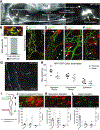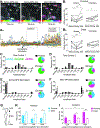Sympathetic Input to Multiple Cell Types in Mouse and Human Colon Produces Region-Specific Responses
- PMID: 32980343
- PMCID: PMC7956113
- DOI: 10.1053/j.gastro.2020.09.030
Sympathetic Input to Multiple Cell Types in Mouse and Human Colon Produces Region-Specific Responses
Abstract
Background & aims: The colon is innervated by intrinsic and extrinsic neurons that coordinate functions necessary for digestive health. Sympathetic input suppresses colon motility by acting on intrinsic myenteric neurons, but the extent of sympathetic-induced changes on large-scale network activity in myenteric circuits has not been determined. Compounding the complexity of sympathetic function, there is evidence that sympathetic transmitters can regulate activity in non-neuronal cells (such as enteric glia and innate immune cells).
Methods: We performed anatomical tracing, immunohistochemistry, optogenetic (GCaMP calcium imaging, channelrhodopsin), and colon motility studies in mice and single-cell RNA sequencing in human colon to investigate how sympathetic postganglionic neurons modulate colon function.
Results: Individual neurons in each sympathetic prevertebral ganglion innervated the proximal or distal colon, with processes closely opposed to multiple cell types. Calcium imaging in semi-intact mouse colon preparations revealed changes in spontaneous and evoked neural activity, as well as activation of non-neuronal cells, induced by sympathetic nerve stimulation. The overall pattern of response to sympathetic stimulation was unique to the proximal or distal colon. Region-specific changes in cellular activity correlated with motility patterns produced by electrical and optogenetic stimulation of sympathetic pathways. Pharmacology experiments (mouse) and RNA sequencing (human) indicated that appropriate receptors were expressed on different cell types to account for the responses to sympathetic stimulation. Regional differences in expression of α-1 adrenoceptors in human colon emphasize the translational relevance of our mouse findings.
Conclusions: Sympathetic neurons differentially regulate activity of neurons and non-neuronal cells in proximal and distal colon to promote distinct changes in motility patterns, likely reflecting the distinct roles played by these 2 regions.
Keywords: GCaMP; Gastrointestinal; Interstitial Cells of Cajal; Platelet-Derived Growth Factor Receptor–α.
Copyright © 2021 AGA Institute. Published by Elsevier Inc. All rights reserved.
Conflict of interest statement
All authors have no conflict of interest.
Figures







Similar articles
-
Optogenetic activation of the distal colon epithelium engages enteric nervous system circuits to initiate motility patterns.Am J Physiol Gastrointest Liver Physiol. 2021 Oct 1;321(4):G426-G435. doi: 10.1152/ajpgi.00026.2021. Epub 2021 Sep 1. Am J Physiol Gastrointest Liver Physiol. 2021. PMID: 34468219 Free PMC article.
-
Extrinsic Primary Afferent Neurons Link Visceral Pain to Colon Motility Through a Spinal Reflex in Mice.Gastroenterology. 2019 Aug;157(2):522-536.e2. doi: 10.1053/j.gastro.2019.04.034. Epub 2019 May 8. Gastroenterology. 2019. PMID: 31075226 Free PMC article.
-
Enteric Neuronal Substrates Underlying Spontaneous and Evoked Neurogenic Contractions in Mouse Colon.Cell Mol Gastroenterol Hepatol. 2025;19(5):101462. doi: 10.1016/j.jcmgh.2025.101462. Epub 2025 Jan 13. Cell Mol Gastroenterol Hepatol. 2025. PMID: 39814102 Free PMC article.
-
Ligand and electrically induced acitivation patterns in myenteric neuronal networks. Confocal calcium imaging as a bridge between basic and human physiology.Verh K Acad Geneeskd Belg. 2008;70(2):105-45. Verh K Acad Geneeskd Belg. 2008. PMID: 18630723 Review.
-
Interstitial cells of Cajal: primary targets of enteric motor innervation.Anat Rec. 2001 Jan 1;262(1):125-35. doi: 10.1002/1097-0185(20010101)262:1<125::AID-AR1017>3.0.CO;2-I. Anat Rec. 2001. PMID: 11146435 Review.
Cited by
-
Unique properties of proximal and distal colon reflect distinct motor functions.Am J Physiol Gastrointest Liver Physiol. 2025 Apr 1;328(4):G448-G454. doi: 10.1152/ajpgi.00215.2024. Epub 2025 Mar 17. Am J Physiol Gastrointest Liver Physiol. 2025. PMID: 40095602 Free PMC article. Review.
-
Dysautonomia in Amyotrophic Lateral Sclerosis.Int J Mol Sci. 2023 Oct 5;24(19):14927. doi: 10.3390/ijms241914927. Int J Mol Sci. 2023. PMID: 37834374 Free PMC article. Review.
-
The parasympathetic and sensory innervation of the proximal and distal colon in male mice.Front Neuroanat. 2024 Jul 9;18:1422403. doi: 10.3389/fnana.2024.1422403. eCollection 2024. Front Neuroanat. 2024. PMID: 39045348 Free PMC article.
-
A gatekeeper sympathetic control of lacrimal tear secretion and dry eye onset through the NA-Adra1a-Ucp2 pathway.Nat Commun. 2025 Jun 5;16(1):5215. doi: 10.1038/s41467-025-60476-z. Nat Commun. 2025. PMID: 40473608 Free PMC article.
-
Molecular and functional diversity of the autonomic nervous system.Nat Rev Neurosci. 2025 Jul 3. doi: 10.1038/s41583-025-00941-2. Online ahead of print. Nat Rev Neurosci. 2025. PMID: 40610604 Review.
References
-
- Schneider S, Wright CM, Heuckeroth RO. Unexpected Roles for the Second Brain: Enteric Nervous System as Master Regulator of Bowel Function. Annu Rev Physiol 2019;81:235–259. - PubMed
Publication types
MeSH terms
Substances
Grants and funding
LinkOut - more resources
Full Text Sources
Other Literature Sources
Molecular Biology Databases

